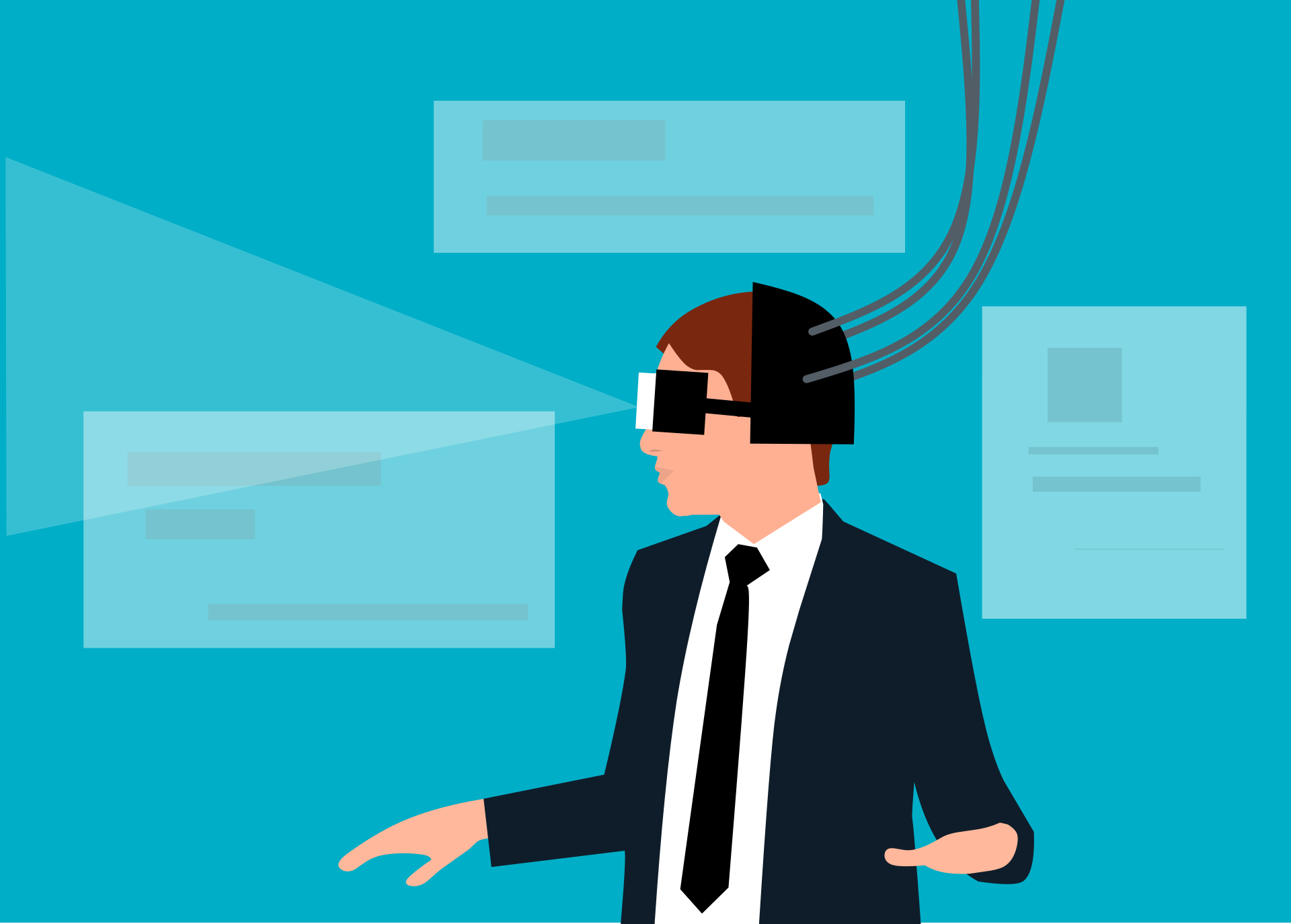Augmented Reality Developments
Augmented Reality Technologies: 2022 AR Research & Applications
What Are The Technologies Used In Augmented Reality?
The technological advancements of the late 20th century and the last two decades have expanded the horizon of AR. That is thanks largely to investments that have been made in the technology, which was $4.1 billion in 2019 alone.
The technologies used in augmented reality (AR) are SLAM (simultaneous location and mapping), depth tracking, and image processing and projection. To make these technologies work together, AR-compatible devices such as smartphones, equipment such as helmets and smart glasses, and AR software or applications, are needed.
How AR Works
SLAM is a piece of technology that allows devices to overlay digital images into the real world. It is aided by localizing sensors to take a total sense of a physical setting.
Depth tracking measures the range of an object or a surface from an AR device’s camera.
Lastly, the AR application or software will process images to get the dimensions and the location correctly.
Working simultaneously, these applications will then project a digitally produced object into a real space. A device with a camera, like a mobile phone or a pair of smart glasses, is essential to making this happen.
The AR software needed for image processing is the tool that can recognize objects using computer vision technology. This tech can read or analyze video streams.
To make it complete, the device will get information on an object from the cloud. The software provides a three-dimensional experience that moves with the user, whose size and orientation are adaptable to the device settings.
The Two Types Of Augmented Reality
There are two different types of AR which are categorized according to how the augmentation is triggered:
Marker-based AR
Markers are unique patterns that cameras can trace from any environment. Users will need an app to scan the markers and trigger an augmented experience that will appear on a device. Depending on the design, the markers or the camera can be moved around to produce various effects.
The downside to this type of augmented reality is that users are totally reliant on apps for the experience.
Markerless AR
Markerless AR is a more versatile type of AR as it doesn’t require visual cues or patterns; rather, it gathers information from the environment via cameras, GPS, digital compasses, and accelerometers of devices. This is where SLAM comes in. It can provide a higher level of flexibility, meaning markerless AR is the more popular option with developers.
There are two variations for this type of AR:
Location-based AR – ties the augmentation experience to a particular setting. The software determines whether an area meets the criteria for projecting virtual objects. This is what the popular game Pokemon Go does.
Projection-based AR – the variation of markerless AR which doesn’t require any user-operated tech. To provide an augmented experience, it projects images onto flat areas. This type of AR is often used for entertainment and practical applications.
Common Software/Applications For Building Augmented Reality
As mentioned above, a piece of software or an application is needed to enable augmented reality. In line with this, there are also platforms that can be used to develop those AR experiences, including:
ARCore – Google’s platform for AR development. It utilizes multiple APIs to allow a user’s phone to map out the environment, understand the setting, and interact with the data it processes.
Apple ARKit – with a cutting-edge framework for augmented reality, the platform from Apple is designed to work with iPadOS and iOS. ARKit 4, the most recent iteration, has a Depth API that is compatable with the LiDAR scanner on the iPad Pro and the iPhone 12 family.
Unity – industry-leading AR development software with tools and a unified workflow for developers, equipped with an XR interaction toolkit enabling users to drop elements into a scene. That means no more coding objects from scratch.
Technologies Related To Augmented Reality
SLAM, image processing, and depth tracking are the main technologies that enable augmented reality. However, there are a variety of other emerging AR technologies that bring it all together. A few examples are cameras, sensors, displays, accelerometers, digital compasses, navigation devices, and gyroscopes, which need to be paired with the right CPU in order to run smoothly.
Moreover, they require suitable devices for AR, such as the following listed below.
AR-compatible devices: These devices are smartphones and tablets that are able to run applications with AR functionality. Smartphone makers will usually list the devices that are enabled for AR.
AR glasses: Smart glasses are glasses that can overlay digital images or information onto a physical environment. They require a camera with a smartphone or tablet connected to them. But there are others that will work with head-mounted displays as well. According to VR (virtual reality) statistics, shipments for AR and VR headsets are taking off.
AR contact lenses: The concept of augmented reality is already Sci-Fi material, but now there are companies that are taking it further. One of these companies is Mojo Vision. It is mainly targeted toward people with sight impairments to give them augmented vision.
AR helmets: AR is now being used in architecture and construction, which makes sense as helmets have been devised to incorporate the technology. One example of this is the DAQRI Smart Helmet, promising to increase site efficiency and ensure a greater level of safety.
Prominent AR Use Cases
One of the most common AR use cases is gaming. But the technology does more than provide a different facet to playing games. As we can see from the increase in corporate and industrial investment in AR software, it is widely used in scenarios other than gaming.
Civil Construction
The use of AR as a civil construction tool goes beyond digital models and 3D plans. With AR, engineers and architects can get an in-depth look at whatever is being built. The tech allows them to understand complex layers that might have otherwise been challenging to perceive.
In addition, design and construction firms can use it for inspection purposes. An inspector can compare a building information model generated by BIM solutions to what is being built. This makes it easier to see discrepancies and to relay information to ensure it is corrected swiftly.
AR For Deaf & Hard-hearing Individuals
Students of Cornell Tech have been working on AR software for deaf and hard-of-hearing individuals as part of a specialization project. The aim is to ease their challenges when having one-to-one and prolonged conversations.
This software has been designed to project captions and pave the way for seamless verbal exchanges. Several other organizations have also begun developing similar devices.
Research & Development
There are a number of different tech companies that are involved in conducting research and development of AR software and products.
According to literature reviews, computer science is currently the leading category in which AR research is being done. Following that is medical care, particularly in the areas of rehabilitation and clinical neurology. Other categories where augmented reality has received much attention are engineering, education, and automation and control systems, among others.
Limitations
Augmented reality is magic. But there are limitations to the technology. The founders of Laan Labs noted that design and development are limited to the technology that is available today. This means that consumers have to set realistic expectations, too.
Additionally, augmented reality is still restricted in some sense, especially on smartphones. One article by DAQRI talks about depth cameras utilized in mobile AR. Consumers may be more familiar with the Xbox 360 Kinect, though—the gaming accessory uses a depth camera in order to capture users’ motions. This technology is back in the public consciousness, thanks to the iPhone X, which integrates a basic form.
There are some complex requirements for mobile AR depth cameras, however. According to smart glasses makers, first, sensors need to be small enough so that they match the size restrictions of headsets. Secondly, they needs to use as little power as possible to prevent overheating. Thirdly, they shouldn’t be demanding in terms of the processing power that the sensor output requires. And lastly, depth cameras need proper calibration. As mobile cameras undergo stress and wear over time, factory calibration may not be long-lasting.
Advances in other areas may provide solutions to such challenges and propel AR technologies to greater heights in the future.
Augmented Reality Developments
Though AR has been around for a while, it wasn’t until less than a decade ago that it started taking off. When looking into the history of AR developments, it is easy to see that smartphones had a huge part to play. Because of these devices, it became possible to put applications and games in the hands of the public. The total number of AR-enabled smartphones is predicted to reach around 5 million by 2023.
Aside from that, there are some other notable trends in the field.
Shopping with AR: IKEA has an app that allows people to envision how items will look in their homes. But it’s not the only retail chain that has thought of this. This approach has also become popular among some fashion brands.
Training in healthcare: The training of surgeons in schools and hospitals has been augmented by AR. Using AR projections, students can practice complex surgeries and gain some proficiency before actually undertaking the operation.
AR for driving assistance: AR is being used in automobiles to assist drivers. The technology is mostly used for navigation. Arrows appear on the heads-up display to guide drivers so they won’t have to look at their mobile devices for directions while driving.
The Reality Of Augmented Reality
Augmented reality is now a commonplace technology, with millions of devices ready to support it. However, there are still challenges that need to be surmounted to create the perfect AR experience. For example, there is the matter of depth sensing (as mentioned earlier); cameras need to meet several important criteria points to be optimal.
There is also the cost issue. While AR has become more accessible to ordinary consumers, AR-enabled devices come with a hefty price tag in most other sectors. Therefore, it will be a long while before civil medical institutions, construction firms, enterprises, and other entities are able to afford widespread implementation.


